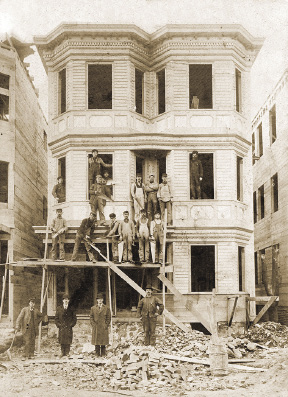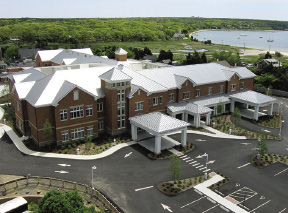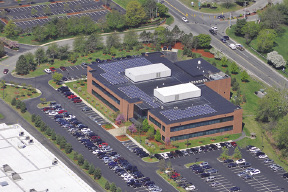Reflecting on the founding of Columbia Construction Company requires journeying back to what was happening in and around Boston in the 20th century. In the early 1900s, Boston was flourishing. As the largest city in Massachusetts, Boston's prosperity attracted many people to the area. The population was increasing, ultimately expanding beyond the original city limits.
The Early Years
Samuel Lilly, founder of Columbia Construction Company, took advantage of this population surge. Working as a trade carpenter at the time with his brothers, Sam was involved in a number of housing development projects. As the need for housing increased, in 1925 Sam Lilly went into business for himself, expanding the family construction business. He continued to build residential buildings, mostly triple-deckers throughout the Boston area. With a majority of construction happening on Columbia Rd. in Dorchester, Sam eventually named the company for the place he found his early success.
In the early years, Columbia Construction prospered. As the business grew, Sam moved Columbia's operations to Boston's Scollay Sq. The firm continued to build residential projects up until the late 1940s. After World War II, Columbia Construction branched out to pursue commercial work. The Boston Public Library's South Boston Branch was one of the firm's first commercial jobs.
All in the Family
In the 1950s, the company moved to Hanover St. in Malden. It was about the time that Sam's son, Murray Lilly, came to work for the company. Murray had accomplished many things prior to joining the firm; he attended college at the University of Michigan, served in the war, and for a short time, worked at Ford Motor Company. After working alongside his father for several years, Murray took over the family business and became president in 1954. During Murray's time as president, a number of family members joined the company. In fact, at one time almost all of the cousins worked for the company. This included Bruce Gordon, who at a young age rode along in the family car while his mother delivered bids for the company. Later, Bruce returned to Columbia to work as a laborer in the field. Reflecting back on this time, now the company's current President, Bruce Gordon recalls: "When I first started in the field, we all had hammers and buckets. We were doing all of the work ourselves!"
Powerful Transitions
During the mid to late 50s, Columbia transitioned into the healthcare market. From 1955-1975 all of Columbia's work was for hospitals and healthcare institutions. The firm created a specialty in this area and was considered the "go to" company for healthcare construction. "Back when Columbia started in the healthcare market, we were the first to practice core drilling and the pumping of concrete, as there was such a need for it in healthcare construction," states Bruce Gordon. "As this construction technique is less invasive, we ultimately bought the equipment and performed all of these services - ourselves."
Columbia outgrew their Malden offices in the late 1960s and built a new headquarters on Concord St. in North Reading. Around this time, Bruce Gordon became a full-time staff member. For years, Bruce and the Columbia team had the privilege of working on healthcare projects, until legislation changed, reducing the number of healthcare projects. When the recession hit in 1973, business was affected, but fortunately the firm's focus had shifted to life science work. It was at this time that Columbia completed their first project for Siemens (Corning Medical Products at the time). The company has been working with the Siemens entity ever since.
Though Columbia continued to work in healthcare and life sciences, in the 1980s the firm moved into hospitality work. At this time tourism was up and the hospitality market was booming. Capitalizing on these types of project successes, Murray's son, Randy Lilly, joined the family business. Having worked as an architect on the West Coast for several years, Randy's experience provided another level of insight into the hospitality market. With Columbia, he consulted on several projects, including the company's first hotel project at the Ritz Carlton in Boston, renovating all 270 guestrooms. Today, Randy serves as the company's executive vice president/treasurer.
"In looking back over 50 years ago, it is amazing to see that we had approximately 10 permanent members on staff, and about 4-5 of them were family. Now, in 2015, we have 110 members on staff and 2 are family, though, we feel everyone at Columbia is family." said Randy Lilly, executive vice president/treasurer of Columbia Construction.
Modern Day Successes
Through the years, the company transitioned into several new markets. As the firm grew, Bruce Gordon took on additional leadership responsibilities, and in 1987 he was appointed president. Ten years later, Jim Marsh joined the firm as senior vice president. Under the guidance of Bruce and Randy, and with the addition of Jim to the leadership team, the company's capabilities and resources were expanded.
In 2005, the company experienced another milestone, moving its offices to a new building at 100 Riverpark Dr. in North Reading, where they are located today. Columbia has been recognized for many accomplishments and successes throughout the years, and remains flexible and innovative. With an annual volume of over $230 million, Columbia Construction ranks in the top ten of Massachusetts' largest construction firms.
In building the company over the last 90 years, Columbia has expanded into six major markets serving clients in the academic, corporate, interiors, healthcare, hospitality, and life science sectors. The firm also has three divisions: Columbia Mainstream, focused on meeting the diverse needs of complex and large scale construction projects; Columbia Interiors, specializing in tenant improvement and interior renovation projects; and Columbia Energy, developed to meet the ever changing energy and sustainability requirements of their clients.
Reflecting on Columbia Construction's humble beginnings, constructing residences on Columbia Rd., to becoming a leader in the healthcare industry, it should come as no surprise that the company built Massachusetts' first LEED Gold hospital, was one of the first construction firms in Massachusetts to utilize BIM technologies, and was an early practitioner incorporating Lean principals into their project delivery. Now, at 90 years old, and under the direction of a forward-thinking and hands-on leadership group, Columbia is well-positioned to continue its steady growth in the Boston area and throughout the northeast in the years ahead.
 (1).jpg)











.png)